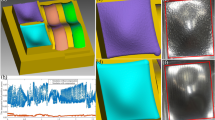Abstract
In process planning for five-axis machining, the key issue is the determination of cutter postures (orientations). In this paper, a simulation-based method is proposed to identify cutter postures that produce minimum deflection cutting force. The method applies to the finish machining process, where only the ball part of the cutter will be engaged with the workpiece. For ball-end cutters, with change of cutter postures, the shape of the engagement region between the cutter and workpiece remains the same. Only the distribution of the engagement region on the cutter surface will change. Based on this principle, a method to transform engagement information between cutter postures is proposed, to eliminate the demand for repeated engagement calculation for different cutter postures. As a result, the computational loads of cutting force calculation for different cutter postures are greatly reduced, which enables us to deploy evolutionary algorithms to search for the optimal cutter posture at a reasonable computational cost.
Similar content being viewed by others
References
Kim YJ, Elber G, Barton M, Pottmann H (2014) Precise gouging-free tool orientations for 5-axis CNC machining. Comput Aided Des 58:220–229
Lee P, Altintas Y (1996) Prediction of ball-end milling forces from orthogonal cutting data. Int J Mach Tools Manuf 36(9):1059–1072
Lamikiz A, Lopez de Lacalle LN, Sanchez JA, Salgado MA (2004) Cutting force estimation in sculptured surface milling. Int J Mach Tools Manuf 44(14):1511–1526
Fontaine M, Moufki A, Devillez A, Dudzinski D (2007) Modelling of cutting forces in ball-end milling with tool–surface inclination: part I: predictive force model and experimental validation. J Mater Process Technol 189(1–3):73–84
Wou SJ, Shin YC, El-Mounayri H (2013) Ball end milling mechanistic model based on a voxel-based geometric representation and a ray casting technique. J Manuf Process 15(3):338–347
Kiswanto G, Hendriko H, Duc E (2014) An analytical method for obtaining cutter workpiece engagement during a semi-finish in five-axis milling. Comput Aided Des 55:81–93
Wei ZC, Wang MJ, Cai YJ, Wang SF (2013) Prediction of cutting force in ball-end milling for sculptured surface using improved Z-map. Int J Adv Manuf Technol 68(5–8):1167–1177
Wou SJ, Shin YC, El-Mounayri H (2013) Ball end milling mechanistic model based on a voxel-based geometric representation and a ray casting technique. J Manuf Process 15(3):338–347
Zhang X, Yu T, Wang W (2014) Modeling, simulation, and optimization of five-axis milling processes. Int J Adv Manuf Technol 74:1611–1624
Zhang L, Feng J, Wang Y, Chen M (2009) Feedrate scheduling strategy for free-form surface machining through an integrated geometric and mechanistic model. Int J Adv Manuf Technol 40(11–12):1191–1201
Milfelner M, Cus F (2003) Simulation of cutting forces in ball-end milling. Robot Comput Integr Manuf 19(1–2):99–106
Azeem A, Feng H-Y (2013) Cutting force prediction for ball-end mills with non-horizontal and rotational cutting motions. Int J Adv Manuf Technol 67(5–8):1833–1845
Huang T, Zhang X, Ding H (2013) Decoupled chip thickness calculation model for cutting force prediction in five-axis ball-end milling. Int J Adv Manuf Technol 69(5–8):1203–1217
Cao Q, Zhao J, Li Y, Zhu L (2013) The effects of cutter eccentricity on the cutting force in the ball-end finish milling. Int J Adv Manuf Technol 69(9–12):2843–2849
Liang X-G, Yao Z-Q (2011) An accuracy algorithm for chip thickness modeling in 5-axis ball-end finish milling. Comput Aided Des 43(8):971–978
Sun Y, Guo Q (2011) Numerical simulation and prediction of cutting forces in five-axis milling processes with cutter run-out. Int J Mach Tools Manuf 51(10):806–815
Tuysuz O, Altintas Y, Feng H-Y (2013) Prediction of cutting forces in three and five-axis ball-end milling with tool indentation effect. Int J Mach Tools Manuf 66:66–81
Lazoglu I, Boz Y, Erdim H (2011) Five-axis milling mechanics for complex free form surfaces. CIRP Ann Manuf Technol 60(1):117–120
Ozturk E, Tunc LT, Budak E (2009) Investigation of lead and tilt angle effects in 5-axis ball-end milling processes. Int J Mach Tools Manuf 49(14):1053–1062
Subrahmanyam KVR, San W, Soon H, Sheng H (2010) Cutting force prediction for ball nose milling of inclined surface. Int J Adv Manuf Technol 48(1–4):23–32
Layegh S, Lazoglu I, Erdim H (2013) Tool deflection in five-axis milling. International Conference and Exhibition on Design and Production of Machines/Dies/Molds, June 2013
López de Lacalle LN, Lamikiz A, Sánchez JA, Salgado MA (2007) Toolpath selection based on the minimum deflection cutting forces in the programming of complex surfaces milling. Int J Mach Tools Manuf 47(2):388–400
Lopez de Lacalle LN, Lamikiz A, Munoa J, Sanchez JA (2005) The CAM as the centre of gravity of the five-axis high speed milling of complex parts. Int J Prod Res 43(10):1983–1999
Souza AF, Berkenbrock E, Diniz AE, Rodrigues AR (2014) Influences of the tool path strategy on the machining force when milling free form geometries with a ball-end cutting tool. J Braz Soc Mech Sci Eng. doi:10.1007/s40430-014-0200-9
Altintas Y (2000) Manufacturing automation: metal cutting mechanics, machine tool vibrations, and CNC design. Cambridge University Press, New York
Zhang Z, Zheng L, Zhang L, Li Z, Liu D, Zhang B (2005) A study on calibration of coefficients in end milling forces model. Int J Adv Manuf Technol 25(7–8):652–662
Engelbrecht AP (2005) Fundamentals of computational swarm intelligence. Wiley, Chichester
Author information
Authors and Affiliations
Corresponding author
Rights and permissions
About this article
Cite this article
Geng, L., Liu, P.L. & Liu, K. Optimization of cutter posture based on cutting force prediction for five-axis machining with ball-end cutters. Int J Adv Manuf Technol 78, 1289–1303 (2015). https://doi.org/10.1007/s00170-014-6719-1
Received:
Accepted:
Published:
Issue Date:
DOI: https://doi.org/10.1007/s00170-014-6719-1



